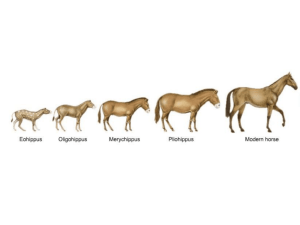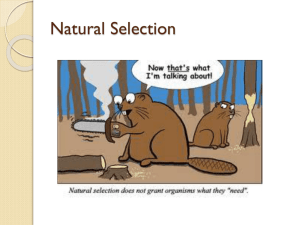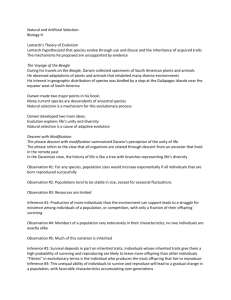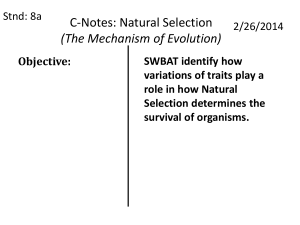Evolution Intro Notes
advertisement
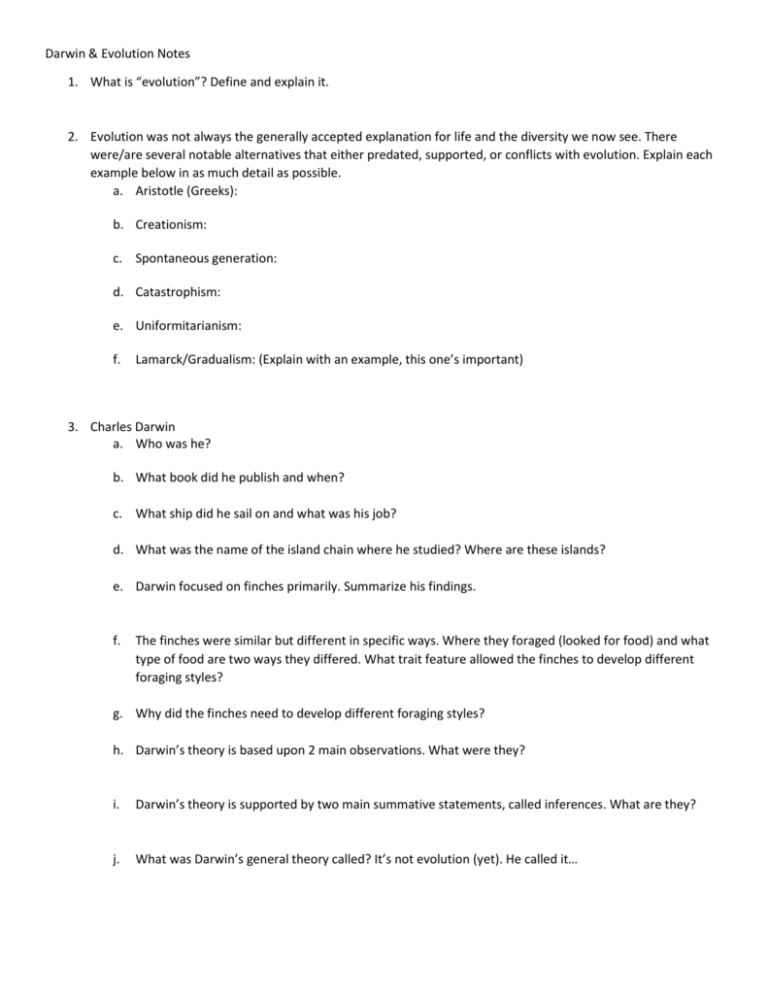
Darwin & Evolution Notes 1. What is “evolution”? Define and explain it. 2. Evolution was not always the generally accepted explanation for life and the diversity we now see. There were/are several notable alternatives that either predated, supported, or conflicts with evolution. Explain each example below in as much detail as possible. a. Aristotle (Greeks): b. Creationism: c. Spontaneous generation: d. Catastrophism: e. Uniformitarianism: f. Lamarck/Gradualism: (Explain with an example, this one’s important) 3. Charles Darwin a. Who was he? b. What book did he publish and when? c. What ship did he sail on and what was his job? d. What was the name of the island chain where he studied? Where are these islands? e. Darwin focused on finches primarily. Summarize his findings. f. The finches were similar but different in specific ways. Where they foraged (looked for food) and what type of food are two ways they differed. What trait feature allowed the finches to develop different foraging styles? g. Why did the finches need to develop different foraging styles? h. Darwin’s theory is based upon 2 main observations. What were they? i. Darwin’s theory is supported by two main summative statements, called inferences. What are they? j. What was Darwin’s general theory called? It’s not evolution (yet). He called it… 4. Darwin’s theory suggests 4 main aspects have to exist in order for evolution to exist. These are called the Tenets of Evolution. They are listed below. Define and explain each in as much detail as possible. a. Variation b. Heredity c. Overproduction d. Differential Selection 5. Natural selection is the means for evolution to occur. Explain what natural selection is. 6. What does the “selecting” in natural selection? Explain. 7. Explain what artificial selection is and how it differs from natural selection. Give an example. 8. In a summative paragraph, explain evolution. 9. Adaptations are inherited characteristics that enhance survival. Acclimations are changes that one goes through to survive in changing environments. They are not the same. For example, moths inherit their camouflage. They cannot change it and their survival depends on blending in with the environment. The best camouflaged will survive and the least will perish. This is an adaptation. Snowshoe rabbits change color depending on the season. In the summer they are brown and in the winter they are white. This is an acclimation. Another example of acclimation is a human’s ability to produce more red blood cells in high elevations so they can maximize in the intake of oxygen. Explain how these terms differ. Summary Questions. 10. Which of the following is the best definition of the Theory of Evolution? a. Individuals that acclimate to the environment will survive and pass on their traits. b. Organisms can pass on their acquire characteristics to their offspring thus forming new species. c. Inherited traits of populations change over long periods of time, sometimes forming new species. d. Once a species is formed, it remains stable over time, and populations do not change. 11. What does Darwin's theory of evolution (descent with modification) state? a. Newer forms appearing in the fossil record are the modified descendants of older species b. Organisms that descend from high elevations are modified as they acquire new traits c. All living things descended from a recent common ancestor on the Galapagos Islands d. Individuals modify their behavior to survive and then pass those modifications on to their descendants 12. Why is the overproduction of offspring a necessary component of natural selection? a. Provide a complete fossil record b. Ensure that genetic information will be passed on through generations c. Acquire lots of advantageous characteristics within a species d. To prevent one species from overpopulating an area 13. According to Darwin’s theory of natural selection, which individuals tend to survive? a. Those that have characteristics their parents acquired by use and disuse. b. Those that have the greatest number of offspring. c. Those that have variations best suited to the environment. d. Those that have characteristics that plant and animal breeder’s value. 14. These two individuals have changed to fit the environment during their lifetime. Which of the following best explains how they have changed? a. They both acclimated by producing more red blood cells to collect more oxygen b. They both adapted by putting on coats and gloves to keep warm c. They both have acquired characterizes that allow them to survive in the cold d. They both have mutated to survive in the environment
